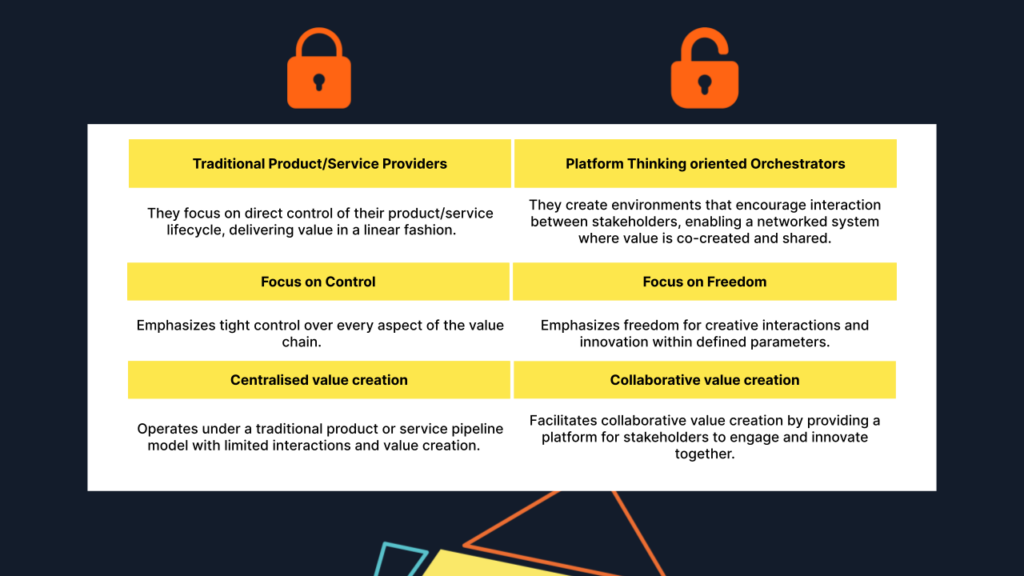
The dichotomy of Platform Thinking: finding the right balance between controlling and orchestrating
Discovers the key balance between control and freedom in platform thinking, advocating collaborative orchestration to maximize value creation
As we have been covering in our previous Platform Thinking related posts, in the ever-evolving landscape of business strategy, this concept has emerged as a game-changer. It revolves around the development of ecosystems where various stakeholders interact to create and exchange value. However, in the pursuit of orchestrating these interactions, a critical challenge arises: finding the delicate balance between control and freedom within a platform. Today, we want to explore the dichotomy between controlling and orchestrating within the realm of Platform Thinking, emphasizing the need for a judicious balance to maximize value creation and ensure ecosystem vitality.

Table of Contents
Presenting the Platform Thinking oriented Orchestrator Paradigm
In contrast, the Platform Thinking mindset envisions the development of an ecosystem where the creator offers a platform to a specific sector’s stakeholders and acts as an orchestrator instead of a controller. Here, the emphasis shifts towards facilitating interactions between ecosystem players, allowing for a more organic flow of value creation. Orchestrators provide the framework and tools for participants to engage and innovate, fostering a collaborative environment. This approach promotes adaptability and responsiveness based on a scalable platform, all of them crucial attributes in today’s rapidly changing business landscape.
Presenting the traditional Controller Paradigm
Historically, companies have operated under the product or service pipeline model. Should it be based on a platform, it typically uses it as a linear and two-sided platform, characterized by being part of a centralized control over every aspect of the value chain. This control-oriented approach extends from the specific content, volume, format and type of interactions between stakeholders, usually not enabling it and being the main intermediary of all interactions. Such tight reins are essential for quality assurance and adherence to established policies. However, this paradigm tends to stifle creative interactions and limit the potential for spontaneous value creation.
Navigating the dichotomy
The challenge lies in harmonizing these seemingly opposing paradigms. Striking the right balance between control and freedom is essential to ensure the success of any ecosystem. Over-control can stifle creativity and innovation, leading to stagnation. Conversely, too much freedom can result in chaos, potentially compromising quality and compliance. It is imperative to recognize that both elements are essential, but their proportions must be meticulously calibrated.
For Platform Thinking to flourish, control and freedom must coexist symbiotically. Companies must act as astute orchestrators, providing a structured framework that allows for creative interactions to thrive within defined parameters. This coalescence creates an environment where innovation flourishes, while maintaining quality and compliance standards. It is this delicate dance between control and freedom that fuels the vitality of the ecosystem and it should be constantly renewed.

Monitoring and Fine-Tuning
To ensure the efficacy of this balance, continuous monitoring of interactions and value creation is imperative. Data-driven insights offer valuable feedback on the effectiveness of control mechanisms and the level of freedom afforded. Fine-tuning becomes an ongoing process, allowing companies to adapt to changing dynamics and optimize the ecosystem’s performance to navigate the presented dichotomy with finesse.
Optimizing Business Ecosystems: Nucleoo’s Approach
In the constantly evolving landscape of business strategy, navigating the dichotomy between control and freedom is critical. As you strive to orchestrate your ecosystem, finding the delicate balance ensures vitality and value creation. Nucleoo strives to transform these complex challenges into opportunities. Our Platform Thinking expertise, backed by a robust technology stack, enables your business to effectively achieve this balance. Let us guide you in the art of orchestrating, innovating and fine-tuning your ecosystem for maximum value creation.

Written by
Mayi Echeveste Schredelseker – Client Strategy and Growth Executive

